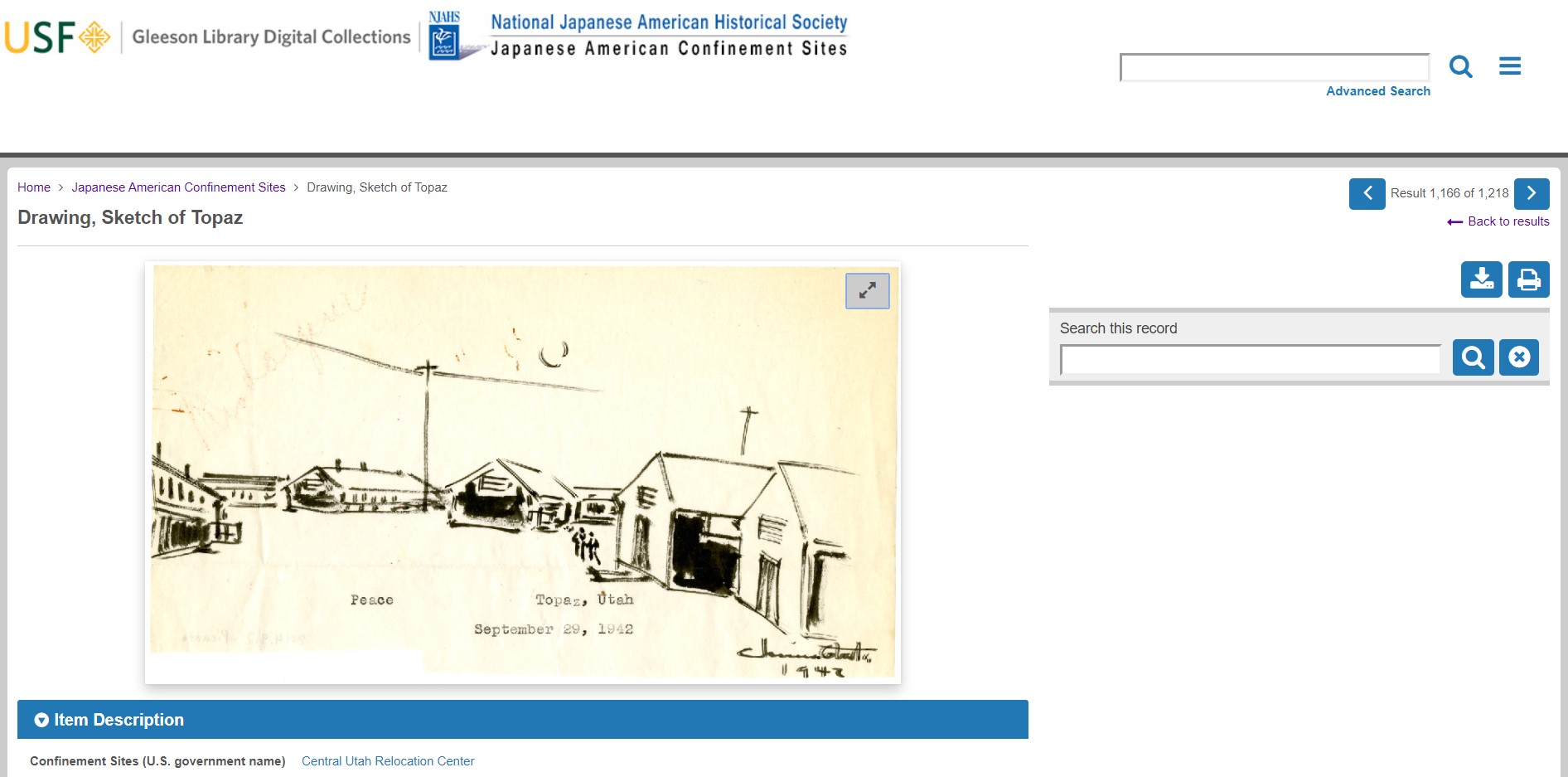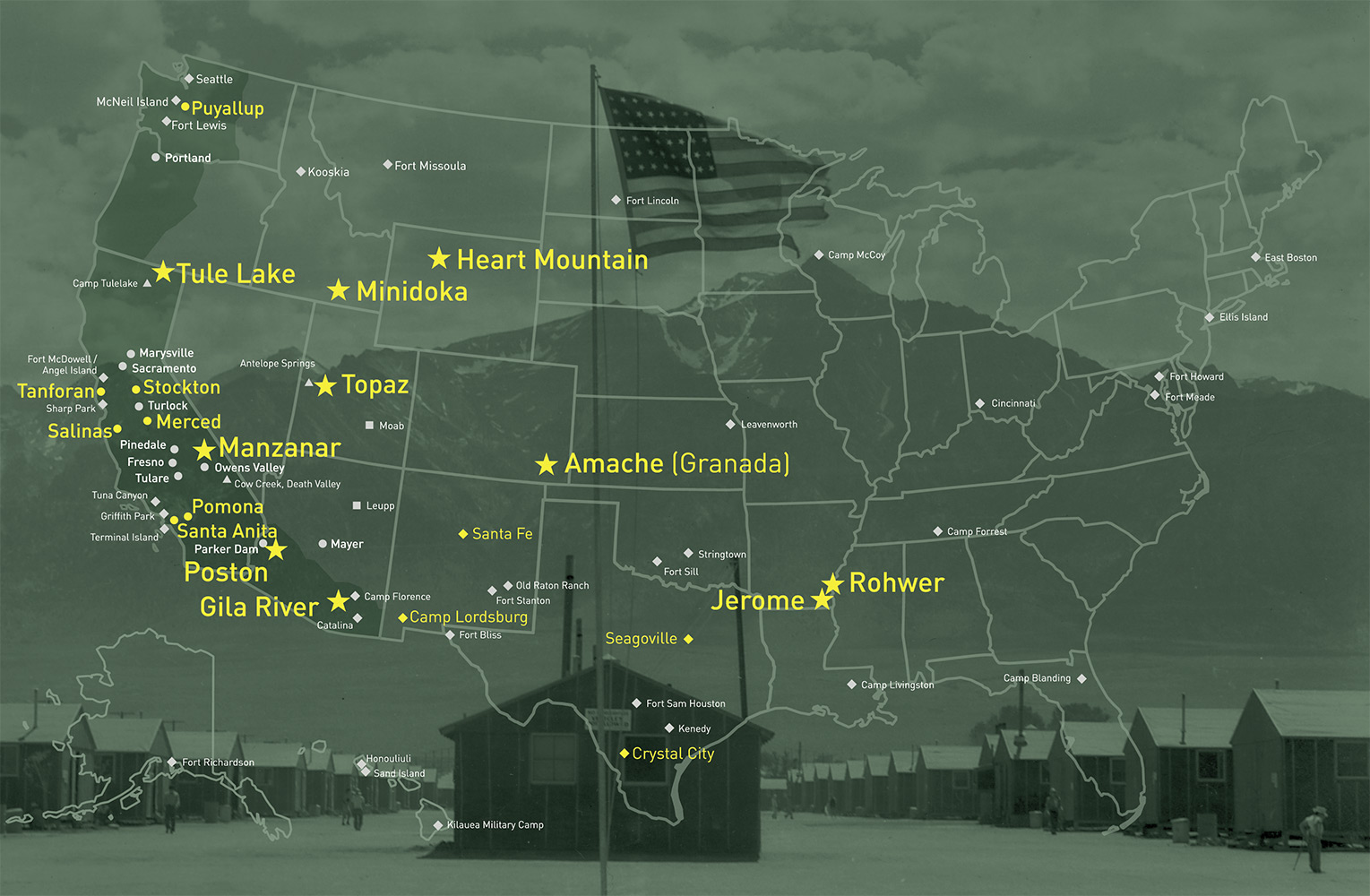1. Browse the full collection on the University of San Francisco Library’s Digital Collections site.
 You will find a list of every NJAHS Collection entry in the USF Library’s Digital Collections database. The collection is housed in the Printing and Art Collections and has been named “Japanese American Confinement Sites.” Click on an object to view images and metadata. To zoom in, crop, etc., click the “expand” button in the top right corner of the image and use the viewing tools on the upper bar of the image viewer. The zoom feature is particularly useful for the large format architectural drawings.
You will find a list of every NJAHS Collection entry in the USF Library’s Digital Collections database. The collection is housed in the Printing and Art Collections and has been named “Japanese American Confinement Sites.” Click on an object to view images and metadata. To zoom in, crop, etc., click the “expand” button in the top right corner of the image and use the viewing tools on the upper bar of the image viewer. The zoom feature is particularly useful for the large format architectural drawings.
2. If you are interested in a particular confinement site, use the interactive map on the Home page of this website.
 This map will take you to images for each site by type: 1) architectural drawings, 2) engineering plans or maps, 3) objects, 4) documents, 5) photographs, and 6) oral histories from the National Japanese American Historical Society’s collection.
This map will take you to images for each site by type: 1) architectural drawings, 2) engineering plans or maps, 3) objects, 4) documents, 5) photographs, and 6) oral histories from the National Japanese American Historical Society’s collection.
Finding Aid
Click on the categories below to browse oral history interviews by keywords and topics of interest.
Collection Summary and Administrative Information
Collection Title: Drawings, Maps, and Artifacts of Japanese American Confinement Sites
Date (inclusive): Original website created April 30, 2010; new website published August 26, 2013
Date (bulk): bulk 1942-1945
Collection Provenance: The collections of the National Japanese American Historical Society (NJAHS), Lynne Horiuchi, Jimi Yamaichi, and the National Archives and Records Administration.
Extent: There are 162 images scanned from maps and drawings, 382 digital images of objects, 486 scans of documents, 202 scans of photographs, and 193 oral history interview excerpts from NJAHS’ collection, totaling 1,425 unique entries in the online database as of March 5, 2021. These artifacts, drawings, and maps are associated with:
10 Relocation Centers: Topaz, Poston, Amache, Gila River, Heart Mountain, Jerome, Manzanar, Minidoka, Rohwer, and Tule Lake.
10 Assembly Centers: Fresno, Marysville (Arboga), Merced, Pomona, Puyallup, Sacramento (Walerga), Salinas, Santa Anita, Stockton, Tanforan
7 Department of Justice Internment Camps and U.S. Army Facilities: Crystal City, Ellis Island, Fort Lincoln, Lordsburg, Santa Fe, Seagoville, Sharp Park
Repository: University of San Francsico Gleeson Library Digital Collections. The artifacts shown are from the National Japanese American Historical Society’s Collections and were brought to or produced in the Japanese American Confinement Sites During WWII. Oral histories of Japanese Latin Americans were produced by the Japanese Peruvian Oral History Project. A number of digital images of maps and drawings and are the property of the owners, Lynne Horiuchi and Jimi Yamaichi, who have lent their digital scans to NJAHS for the purpose of providing digital access to them. The U.S. government produced the majority of the architectural/engineering drawings, plans, and maps in the collection.
Abstract: The goal of this website is to provide access to the NJAHS collection, as well as images relating to the planning, design, and construction of Japanese American confinement sites during World War II, specifically the “Relocation Centers.” These were ten semi-permanent sites located in isolated areas of the western United States and Arkansas. The website has since expanded to incorporate WRA temporary “Assembly Centers,” U.S. Army Facilities, and INS Department of Justice internment camps. The map is meant to reflect the collection in the USF Database, and not the actual number of Japanese American confinement sites. The collection includes three types of images: 1) architectural drawings, 2) engineering plans or maps, 3) objects, 4) documents, 5) photographs, and 6) oral histories from the National Japanese American Historical Society’s collection.
Languages Represented: Collection materials are in English.
Physical Location: Many of the objects, documents, photographs and oral histories can be found at the National Japanese American Historical Society. 1684 Post Street, San Francisco, CA. 94115. Many of the plans, maps and drawings may be found in the National Archives and Record Administration (NARA) facilities.
Languages Represented: Collection materials are in English and Japanese.


